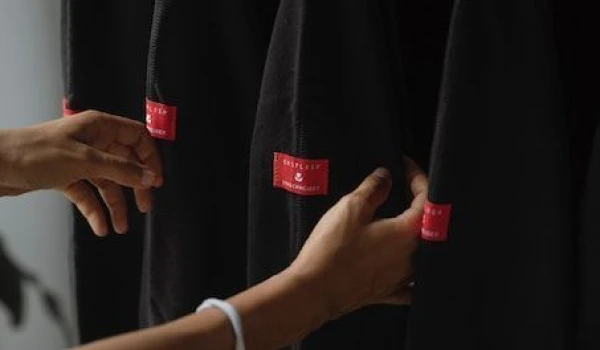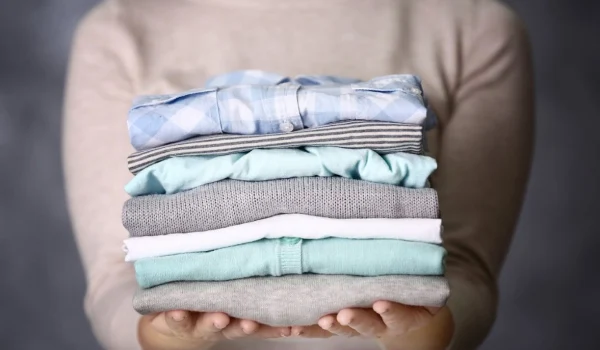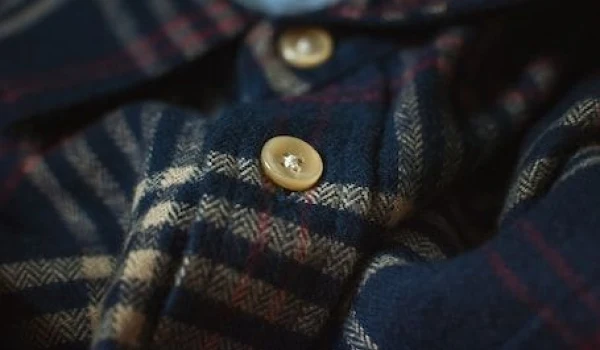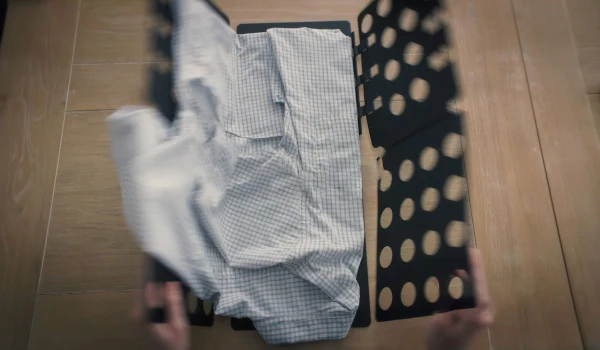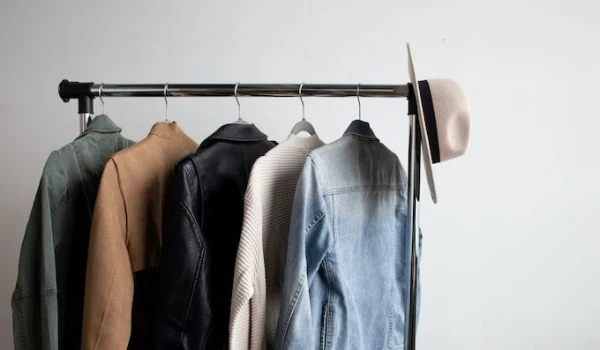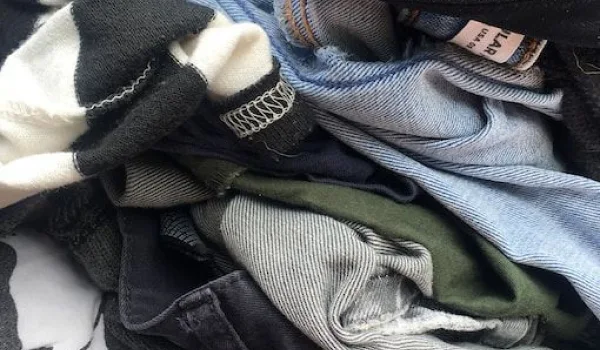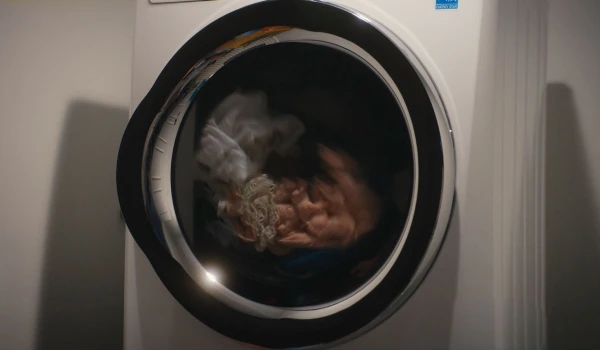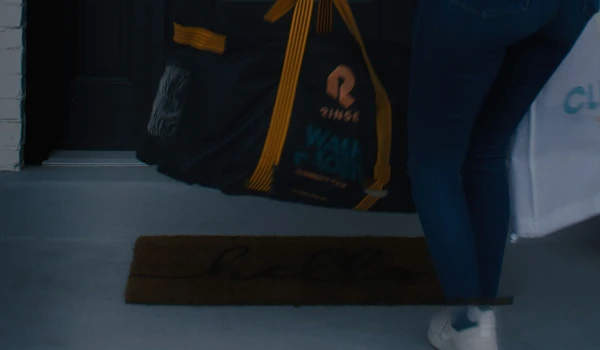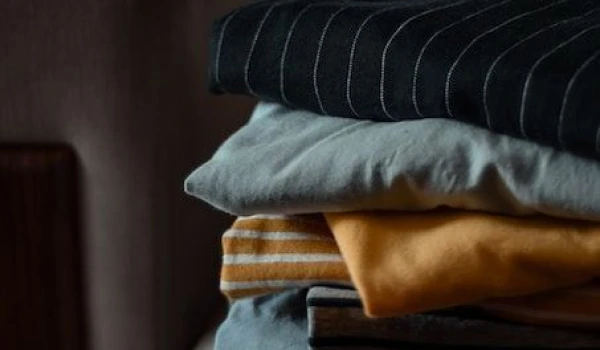Care
Clothing care tips to make your wardrobe last

Transform your closet and get organized - check out our tips below!
Whether your closet looks like you were just visited by Marie Kondo or a Dothraki Horde, we could all do with a couple organization tips to keep our closet manageable and our clothes in optimal condition.
It’s okay, these organization tips will still be helpful long after the references above ;)
So read on! It’s time to clean up your closet and create a polished and personalized space that you can enjoy each time you get dressed.
Keep your daily essentials in the front row
You've heard the phrase "out of sight, out of mind"—while that usually applies to former flames, the same rule also works for closet organization.
Store your least-worn items at the back so you can dedicate prime closet real estate to your most beloved pieces. This will make getting dressed a lot more convenient, and you'll avoid the all-too-familiar situation of rummaging through the closet and ending up with a pile of discarded clothes on the floor or bed.
Style tip: Organize your go-to accessories, like a classic watch or simple jewelry, on a small tray next to your closet. Having them visible will encourage you to wear them and give you a more complete and polished look.
Think like a pro: know when to fold 'em

It might seem basic, but improper storage can cause a garment to lose its shape. Make sure you properly note which items to fold and which items to hang.
Clothes you should fold: Gently fold delicate items such as cashmere sweaters and heavy knits. For extra care you can add a layer of acid-free tissue between garments.
Denim should also be folded, as hanging can cause it to stretch out in the wrong areas. Casual items such as T-shirts and tops can work both ways, based on personal preference.
Clothes you should hang: Keep your outerwear fresh by hanging them for storage. Your vintage leather jacket, silk blouse or suit would appreciate the extra TLC.
Invest in some flocked hangers with velvet lining to keep your choice garments in mint condition. As always, any cocktail attire is best stored in a garment bag.
Out of season items don’t need prime real estate
Before putting anything in the closet at the end of each season, make sure your clothes are prepped for storage.
Launder items as needed, or send your clothes to a trusted dry cleaner for professional service—especially important for winter coats. This removes any scents or stains, as moths are attracted to undetectable smells.
Don't forget to clean your closet at least once per season (it can get dusty). It's also a good idea to go through and remove any items you don't wear on a regular basis. Consider selling or donating the pieces that are in good condition—doing so will help keep your closet organized as well as help those in need.
The elements of style: invest in the right storage

The essentials: Storage bins are your best friend. Instead of unsightly plastic bins, consider linen storage organizers. Fabric organizers help your clothing stay fresh by allowing air to circulate. Try borrowing elements from Scandinavian decor, such as a set of wooden or copper hangers, to help your closet achieve a minimalist and uniformed aesthetic.
The extras: Personalizing your space does not always require an involved process. Switching out little things can make a huge difference, such as adding some decorative items or art in or around your wardrobe. You can also paint or wallpaper the inside of your closet to inject a little more color and personal style.
Fill some sachets with dried lavender buds and place them in your closet to keep your clothes smelling great and repel any moths that might be creeping around your wardrobe—it's a pleasantly scented alternative to using moth balls.
Cedar chests are also a smart choice for woolens, as Red Cedar has natural oils that kill moth larvae (it's a good idea to first put the clothing in a resealable plastic bag for more protection).
While closet maintenance might seem like a chore, keeping these tips in mind will help you streamline the process and stay organized. Just like a morning workout or healthy breakfast, a well organized closet and easy to access closet helps set the right tone for the day -- the great one that you deserve!
Photos: WorldWide / Shutterstock.com, Chelsea Francis, Milada Vigerova, Crew, Mary Whitney
Socks are prone to getting ripped, dirty, and easily worn out. They are also arguably the most important piece of your daily outfit. Find out how to keep them in good condition.
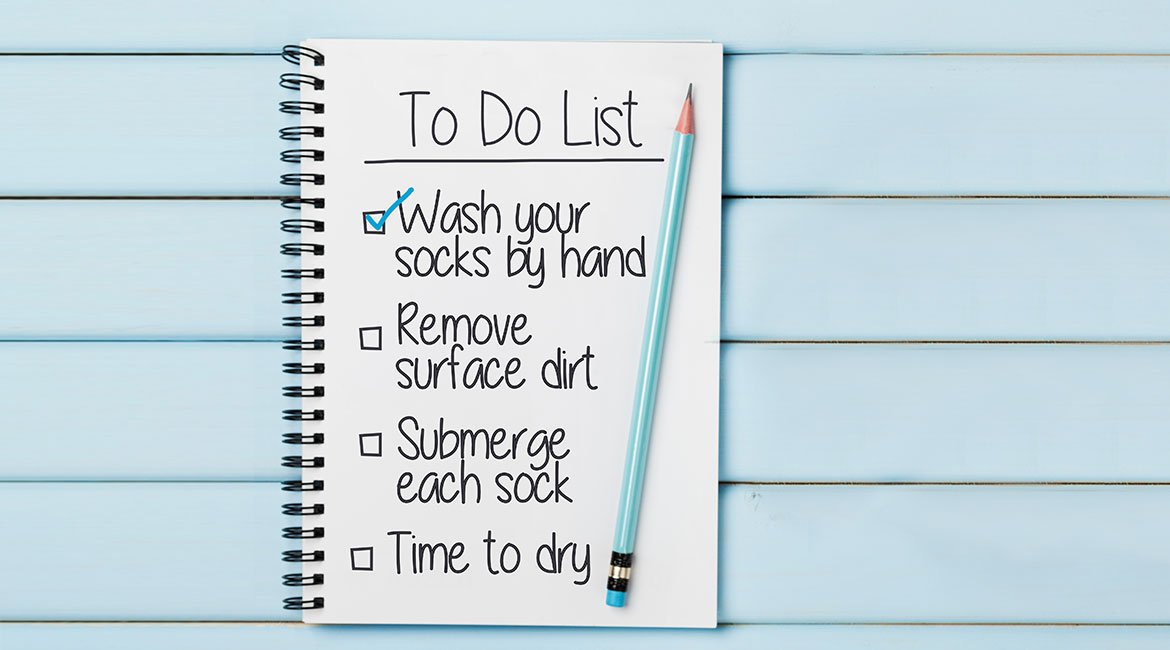
Disclaimer: The views and guidelines in this article are not intended to be taken literally nor do they reflect the practices and views of Rinse and our cleaning partners. They are solely intended for entertainment and are not recommended by Rinse to be carried out.
Throughout December it has been clear we spent a lot of time focused on socks. In the spirit of being light-hearted, we thought we’d wind down the month with a fun take on cleaning socks!
Socks are arguably the most important piece of your daily outfit. Everyone sees them. They produce a welcoming aroma. They protect the most beautiful part of your body, feet. It is imperative to take extra special care of socks! Here’s how.
It is recommended to wash your socks by hand. You will be able to give them the special attention and care they deserve, and it is an excellent use of your spare time. Be sure to use a freshly cleaned sink filled with warm water.
It is also recommended to clean the sink prior to use by wiping it down with other clothes as this creates additional laundry for you to care for after you finish cleaning your socks. All laundry should be treated and cared for equally!
Remove surface dirt by using a toothbrush. Toothbrushes are not only good at removing plaque off of your teeth, but they are also useful when attempting to remove dirt off of your socks prior to soaking them in water. Pro Tip: electric toothbrushes speed up this process and enable you to clean more socks at a faster rate!
Be sure to physically submerge each of your socks in water for at least two minutes. This will ensure the socks are thoroughly cleaned and you will receive wrinkly bath fingers. If you don’t receive wrinkly fingers you are not caring for your socks properly.
Use a blow dryer to dry each sock. Pro Tip: place your hand inside the sock as if you were using it as a puppet. This serves dual purposes. It allows you to properly dry the sock and you may stumble upon an impromptu puppet show.
Well, that was fun! While it may sound like those are great tips we cannot omit the fact that these tips are for entertainment. When in doubt schedule a Rinse and we’ll provide the best care for your socks and the rest of your items!
Happy Holidays and Happy Rinsing!

Costumes are oftentimes made of inexpensive material, therefore, they may not last very long. Learn how to extend the lifespan of your costumes!
Whether you went all out in a spectacular costume or kept things simple as a ghost or a cat, the special care required to keep Halloween costumes clean can easily be overlooked.
Costumes are often made of inexpensive materials, like acetate or acrylic, and feature basic structure and stitching that are designed for one-time wear. So what happens when you find a great costume that deserves some extra mileage in future years? Carefully cleaning and storing your costume will ensure it can be re-used for the next spooky party.
Our guide will help you properly care for your Halloween costume so that it continues to trick without getting ruined by any treat-induced stains.
Pre (trick or) treat

While you’re enjoying some candy, a melting chocolate bar or dripping caramel from a candy apple may make its way onto your costume. To take care of any Halloween food stains, pre-treat with a stain remover formula and let it soak for about 30 minutes. Costume fabrics usually aren’t particularly breathable, so you’ll also want to pre-treat areas where perspiration stains have occurred (such as under the arms and around the neck).
Keeping clean
Machine wash
Check your costume’s label for recommended washing instructions. If your costume is made out of cotton, polyester, acrylic or nylon, and doesn’t have special embellishments, it can likely be machine washed in cold water on the delicate cycle.
Hand wash
Costumes made of tulle or spandex can be gently hand-washed at home, even if they have sequins or plastic attachments. However, careful consideration must be taken when you’re cleaning these items yourself.
- Flip the costume inside out before placing it in cold water with a gentle laundry detergent.
- Knead the material in the water for a few minutes, then rinse thoroughly.
- Gently squeeze the costume to remove excess water, but take care not to wring it, which can weaken the stitching.
Professional care
Costumes labeled as “dry clean only”—especially with special embellishments or trims made of fur, leather, suede or feathers—should be taken to a professional, who will be equipped to provide a thorough cleaning.
Dry and iron
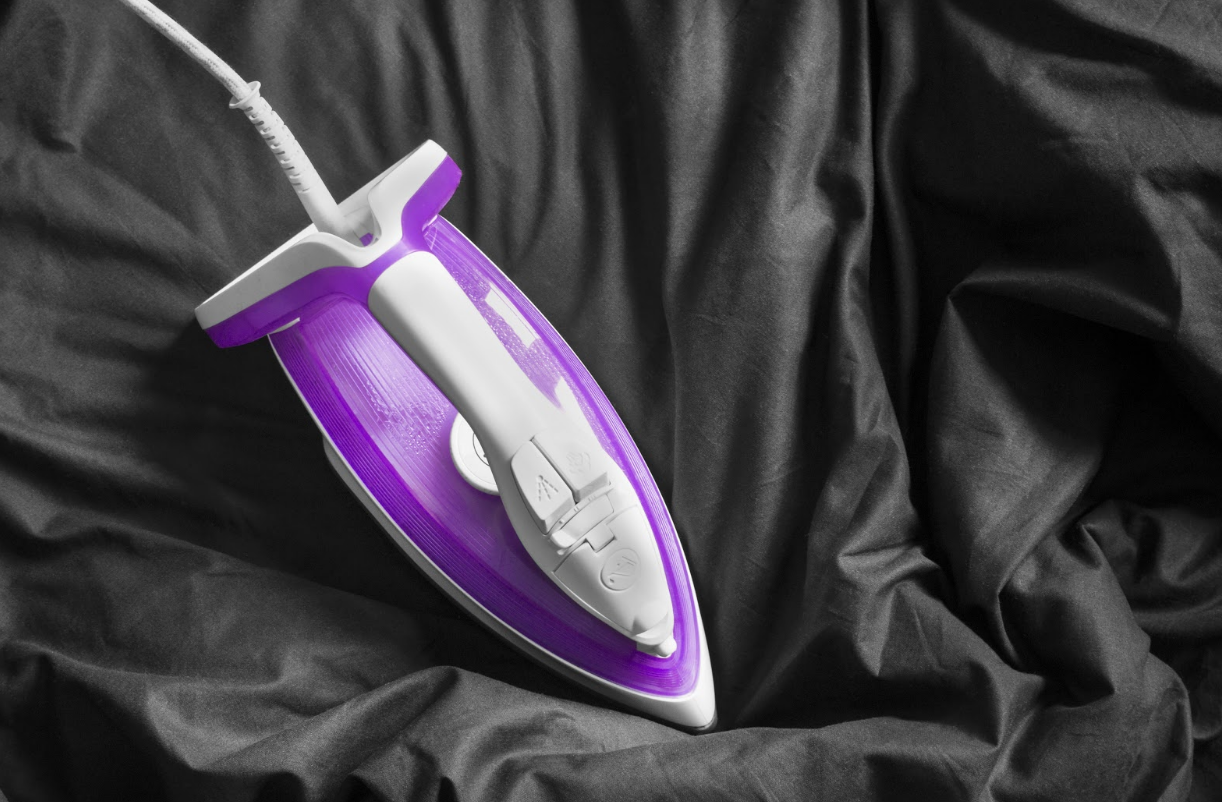
Avoid the dryer, which can shrink a costume made of inexpensive fabrics (like acetate and polyester) by up to two sizes or ruin the material altogether. The dryer can also loosen the elasticity in spandex or nylon. Most costumes should be hung to dry, but ones with a distinct structure should be laid flat to dry in order to preserve their shapes.
If you need to remove any wrinkles, iron on the lowest heat setting. High heat can damage fabrics like acrylic, rayon and polyester. Always keep the iron moving so that you avoid overheating and ruining the fabric
Next season storage
To ensure that your favorite Halloween costume looks just as good next year, be extra diligent about storing it properly.
- Delicate costumes with attachments or different parts should be hung so the material doesn’t stretch. Place them in a plastic garment bag and store in the closet until next year.
- If your costume is made of a durable material, fold it carefully and store it in a sealed freezer bag to keep dust and mold out.
- Costume accessories like broomsticks or wands should be wrapped in bubble wrap and kept safely in a box.
- Stuff hats with paper to maintain their shape.
- Place wigs on a styrofoam wig stand and keep them tucked in a sealed bag or box.
Halloween costumes aren’t meant to be worn all the time, but you might want to keep your favorite outfit on hand for future parties. By taking special care of your costume, you’ll make sure it gets a chance to scare again.
Photos: Jill Wellington for Pexels / Eugenio Marongiu / Shutterstock.com, jp26jp, Tarzhanova / Shutterstock.com

Let’s face it, “business casual” is a perplexing term that can be interpreted in many ways. You might get away with an open-collared shirt and jeans in one office, while in another workplace you might expected to show up wearing a tie or a skirt.
While “business formal” usually refers to a suit and tie for men, and dress pants with a matching jacket for women, “business casual” is its less buttoned-up cousin. You have some freedom to inject your own unique style into your outfit with accessories and atypical silhouettes, while maintaining a stylish and professional appearance.
So what does that really mean? Whether you work in a creative or corporate office, we solve this vague dress code once and for all. Here’s our guide to dressing “business casual.”
Tops: button-down shirts and blouses

Women: A “business casual” top can be a silk blouse or a crisp button-down shirt. At a creative company, play with silhouettes like bell sleeves or ruffles. You can add some tasteful flair by accessorizing with a dressy belt or statement necklace.
Men: A tailored button-down shirt in solid colors or subtle plaids is a polished look. Show off your layering skills with an unstructured sports jacket or half-zip sweater.
Care tip: Ink stains can strike when you least expect them. Blot the stain with some rubbing alcohol—which works on most fabrics—and place a paper towel over it to absorb the liquid. (Avoid using club soda, which can set ink stains.) While a professional is most equipped to clean silks, you can toss cotton shirts in the washing machine using cold water, and then hang them to dry.
Bottoms: dress pants and chinos
Women: Choose dressy work pants that have enough room to tuck in your top. For dresses and skirts, ensure hemlines fall no more than 1” above the knee, and stay away from casual fabrics like jersey or linen.
Men: Dress pants or chinos are your go-to options. Keep them well-pressed with a steamer to maintain a professional appearance.
Both: Dark denim works in casual offices, but make sure there are no tears, rips or distressed patterns. Ladies can opt for sophisticated cuts like wide leg trousers or skinny jeans, while men can go for modern straight/slim-fit styles.
Care tip: If you find yourself wearing your lunch, use a mix of soap and water to get as much of the stain out as possible. Once you’re back home, pre-treat with a stain removal stick and launder according to the
Shoes: classic pumps and leather loafers
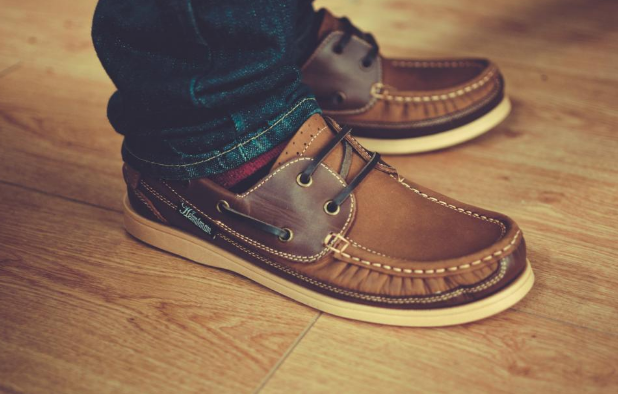
Women: Slip into ballet flats or classic pumps with a heel no more than 3” high. In less formal offices, suede or leather ankle boots are a fashion-forward yet professional option.
Men: Sleek leather loafers are a great choice, but you can have some fun with hybrid dressy-casual leather sneakers in a creative work environment.
Both: Leave the flip flops and athletic shoes at home, unless you ever find yourself working outdoors.
Care tip: To keep your leather shoes looking their best, wipe any dirt off with a soft damp cloth and gentle soap. Follow up with shoe polish to buff your footwear back to their shiny glory. For suede, use a suede brush to scrub away any blemishes. Refer to our leather guide for more tips on caring for leather footwear.
General tips for dressing business casual

“Business casual” can be confusing, but you can follow these general guidelines to avoid an awkward office fashion situation.
- The type of office you work in and the nature of the workday are important clues to deciphering this dress code. Corporate settings may be restricted to dress pants while startups and creative companies may allow for jeans.
- How your fellow colleagues dress for work will also give you some insight. For example, they may be dressed to the nines for client meetings, but for regular workdays they might show up in casual yet polished ensembles.
- It’s better to play it safe and go for something more formal, not less (so no sweatpants, please). If you’re really in doubt, it never hurts to ask your boss to define your workplace’s version of “business casual.”
Now that you have a better understanding of this perplexing dress code, you can start putting together work outfits that will impress your coworkers and clients. Knock ‘em dead.
Photos: Syda Productions / Shutterstock.com, Unsplash, Vladeep / Shutterstock.com, Alexander Andrews, Aila Images / Shutterstock.com

We’ve all been there... You make one small movement and a frightful tearing sound comes from the seat of your favorite pair of jeans. It has happened to the best of us and despite our better judgement, we’ve all kept a pair of pants around for one wear longer than we should have.
Everyone has ripped a hole in their jeans… You’re not alone!
It’s time we talked openly and honestly about the reality of that unfortunate tear in the seat of your pants.
When jeans begin to rip, which typically a sign that the jean is nearing it’s end, it is usually the result of a seam burst or tear in the seat of the jean. Adding a patch to the tear in your jeans is a service that most professional cleaners will provide. However, this treatment will only delay the inevitable for a short period of time.
When you apply a patch to denim, you're introducing new and most likely stronger fabric to the garment. As you wear the garment more, the area surrounding the patch will take on additional stress, causing it to wear and eventually tear. Since the fabric of the patch is strong and the surrounding area is most likely weaker, the point of defect usually just moves from the patched tear to the surrounding area.
While a patch may add some extra life to your garment, it's really just a matter of time until you create more damage to the garment. On the bright side, you can think of this as an opportunity to upgrade to that new pair of denim you had your eye on.


Introduction
We all have at least one article of clothing with a care label that says "Hang to Dry." Most of us have probably thought at one time or another, "Do I really have to?" and weighed the risk of throwing that piece in the dryer along with the rest of the laundry.
Well, for all of you who want to avoid turning your favorite pieces into doll clothes, here is a guide on why you should hang dry certain garments and how to do it properly so your clothes continue to last and look great.
Why Hang Dry?
Hanging clothes to dry helps to avoid the heat damage that can be caused by traditional dryers.
Delicate fabrics, such as those used in activewear, underwear, and jeans, can lose their shape and fit due to the harsh tumbling and heat of the dryer. By air drying your clothes on a clothesline or laying them out to dry on a flat surface, you can help your clothes maintain the same fit and form they had when you first bought them.

Benefits of Air Drying Clothes
Promotes Energy Conservation & Saves Money
What better way to reduce energy consumption than by eliminating it? While this is great for the environment, your utility bill will also be significantly lower thanks to the electricity saved from not running your dryer.
Helps Remove Strong Odors
Sunlight is very effective in killing bacteria and removing odors from your clothes. This may be particularly useful for bedding or baby clothes.
Increases Physical Activity
Hanging up laundry is a great way to log in some physical activity, whether that be indoors or outside.
Fabric Preservation
Your clothes will last longer, maintain their elasticity, retain their color, and keep their shape if you keep them out of the high heat and mechanical action of a dryer. There is nothing more gentle than fresh air.
Less Static and Wrinkling
Machine-dried clothes will give clothes a static cling and more wrinkles than air-dried ones. This may result in you having to spend time ironing clothes afterward.
Versatility
Some clothes are not suitable for dryers, such as delicates and linens. You can dry all your clothes in one go by hang drying.
Safety
Lint, dust, and debris can accumulate within a dryer's vent system, posing a fire hazard. Reducing or eliminating the use of dryers will keep you safe from such risks.
Peace & Quiet
Dryers tend to be loud and cause vibration, something air drying avoids.

How To Properly Hang Dry
Check the care label and wash your clothes accordingly. The clothing label will direct you to the best method, be it a machine washer or by hand with hot, warm, or cold water. If you’re unsure what those comically unintuitive care symbols mean, you can reference our handy laundry symbol guide.
Hanging your clothes outside on a clothing line? Follow these tips:
- Pants: Hang your pants upside down. Make sure to match the inner leg seams of the pants, and then place the clothespins on the hems while attaching them to the clothesline.
- Shirts and tops: Also hang these upsides down. Place the clothespins at opposite ends of the bottom hem of the shirt or top, and pin them to the clothesline.
- Socks: Hang socks in pairs and upside down. Attach the clothespin to the toe area of the sock and let the top part of the sock hang down.
- Bed linens: Since sheets and blankets can take up a lot of space on the clothesline, you should fold them in half and pin each end to the clothesline.
- Underwear and bras: Hang underwear from opposite sides of the upper seams, and bras from their hook end.
Drying your garments inside? Tips to help them dry quicker and look their best:
- Make sure to lay your clothes on a flat surface when air-drying garments inside.
- Be sure to leave some room between garments to allow air to circulate between them. (A wet pile of clothes is a wet pile of clothes whether you carefully created that pile or not. The key to successful air-drying is ventilation).
- Place your clothes near a window, vent, air-conditioner, or fan to speed up the drying process.
- Don’t have enough space to lay everything flat to dry? No problem – the key is prioritization.
- Sweaters and other garments made from heavy or stretchy material should always be laid flat to dry.
- Other types of garments like yoga pants, swimsuits, jeans, etc can be hung inside using hangers or a drying rack.

How to Get the Best Results
Start Early in the Morning
Check the weather (and pollen!) forecast and get outside early to take advantage of a full day of sunlight. This is especially important if you have heavy items that will require more time to fully dry. While it depends on the weather, it can take at least two to three hours for clothes to dry outside. Make sure you are not folding damp clothes as this may result in mold or mildew growing.
Blot Wet Towels Before Hanging
Towels are designed to absorb water. As such, they will come out of the washer very wet and take a long time to dry. To speed up the process, blot the wet towel by placing it on a dry towel before hanging it. Once excess moisture has been transferred, place both towels on the drying line.
Give Clothes a Shake
Gently shake out each garment once it comes out of the washer. This helps remove wrinkles and smooths out fabric folds.
Hang the Largest Items First & Secure Them in Place
Maximize the space on your line by hanging sheets first, then towels, and then clothes. Keep at least an inch of space between pieces to ensure adequate airflow and prevent mildew growth. Use plastic hangers and clips to maintain them in place – just be gentle with delicate fabrics and avoid leaving marks or stretching.
Fold Laundry as You Remove It from the Line
Avoid wrinkles and fold your clothes as you remove them from the drying line and into a laundry bin. From there, put them away as soon as possible to ensure crisp fabrics.
Mind the Sun
White clothing and linens should sit in direct sunlight to help bleach these garments. When it comes to bright and dark fabrics, place those in a shaded area. This ensures that the dyes are not weakened and prevents fading.

8 Clothes You Should Never Put in the Dryer
Always check the label of your clothes carefully, but the below items are usually a no-go in the dryer:
- Delicate Fabrics: Silk, lace, chiffon, and cashmere can be damaged or shrink at high temperatures
- Wool: Sweaters and suits can shrink and lose their shape
- Bathing Suits: Heat and friction will damage elastic fibers, causing them to stretch
- Leather and Suede: Items can become stiff and discolored – it is better to have these items cleaned professionally
- Running Shoes: Shoes can lose their shape and have the soles separate
- Lingerie with Underwire: The underwire can be bent or damaged in a dryer; bras can become stretched
- Athleisure: Similar to bathing suits, these types of clothes have special fibers that will become stretched and ruined
- Beaded Clothes: The heat from the dryer can cause beads to melt or become distorted
A good rule of thumb: If your garment is made of synthetics, wool, or lace - double-check the clothing label to see if it’s a hang-dry item.
Overcome Hang Drying Challenges
Are you convinced that hang drying is the way to go, but just don't have the time to do it? Well, look no further. At Rinse, we always follow the care label on your clothing and have your hang-dry needs covered. It's just another reason why we're the most trusted brand in clothing care. Try our Hang Dry service and experience our quality cleaning and exceptional customer service for yourself!
Contact us at Rinse today to see our skill in action.
Have laundry or dry cleaning to do?
Rinse picks up, cleans and delivers 7 days a week. Amazingly awesome. Ridiculously simple.

Topics
Rinse Drop
We offer pickup and delivery if you can’t be present between 8pm and 10pm.
Our Valet will pick up or deliver your order to your doorstep or concierge, at which point you’ll receive a text with a photo showing where your items were left.
You can enable Rinse Drop on any (or all) of your orders.


